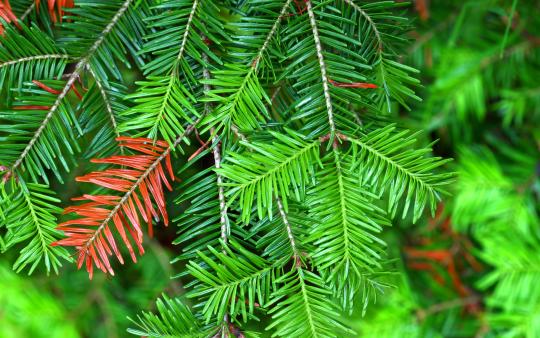Also known as the blister tree, balsam firs are identified by their flat, shiny green needles that have two white stripes underneath and by their unique "blistered" bark, which are actually tiny pockets full of sticky balsam fir resin!
Across the pond
You may be lucky enough to have balsam firs growing where you live, and if you do, you’ve got access to the tools to craft a resin-powered “motorboat” ready to zoom across any pond!
Take a small, sharp twig about 5 cm long and about as thick as a pencil lead. Burst a balsam fir blister with your twig and coat the end of the twig with a nice globule of resin. Carefully bring the twig to a nearby pond or other quiet water source, and place the twig in the water. Watch in amazement as the twig takes off like a motorboat, making twists and turns as it zips along the surface of the water. The resin contains a hydrophobic (water-fearing) oil and when it makes contact with the water it repels water molecules, driving the twig forward!
Don't tap the sap
When rooting around for resin, make sure you’re not mistaking it for sap, a watery liquid found inside a tree’s trunk. Resin, found in pockets inside the bark, is thicker than sap and helps to protect the tree against insects and pathogens.
A resin to believe
Balsam fir resin has been long-used as a topical antiseptic for wounds and infections. It also makes a long-lasting (but very bitter!) gum that can ease hunger. Balsam fir resin has been used for glue, and makes an excellent fire starter on those wet, soggy days!
Moving the needle
The next time you go for a walk, take along some small pieces of sponge and a container of water. Dab a moistened sponge under everyone’s nose: just a little moisture on the upper lip will suffice. The wetness under your nose helps you to distinguish more odours. Try a little “scratch and sniff” by gently rubbing the needles of different conifers (cone bearing trees such as balsam fir, spruce, white pine and eastern white cedar) to release each distinctive smell. Can you identify these conifers by smell alone?
Or try making a smell cocktail. Take along small paper cups, one for each person. Place a few needles from a variety of conifers in your cup and add a bit of soil. Using a twig as a swizzle stick, give the mixture a good stir and sniff the pungent, rich and earthy smell of the forest. Give your concoction a name—perhaps it is “needleicious” or “balsamazing”. What other forest smells can you discover?
You may also enjoy: Seeing the Forest for the Trees, Using the Five Senses to Plug into Nature, and Why Children Need Nature for Future Well-Being.






